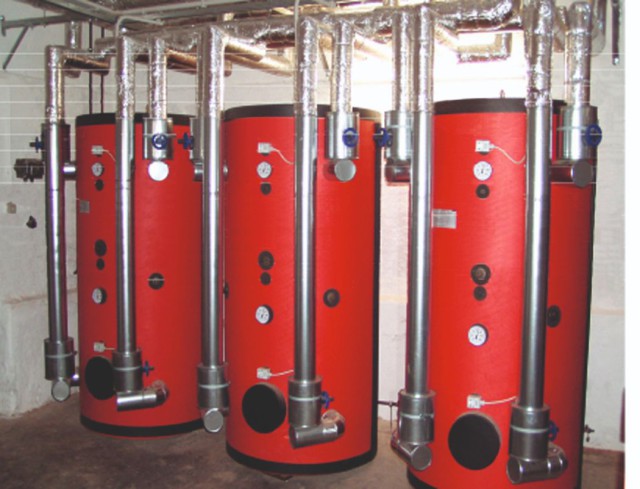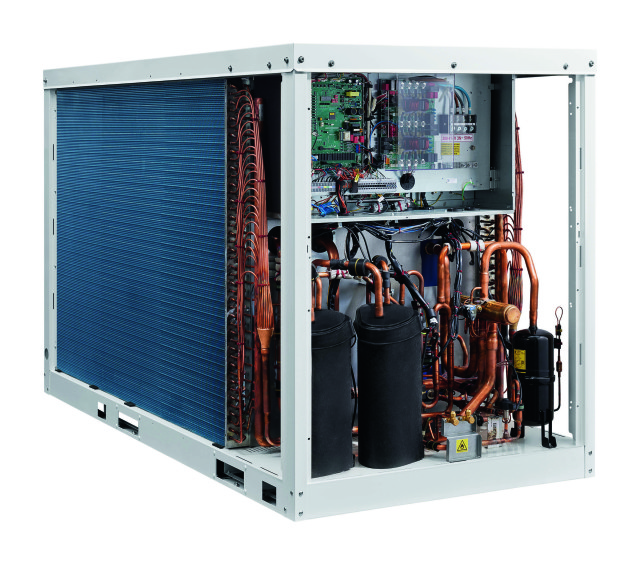Designing to meet high demands for hot water

In buildings where the heat demand for domestic hot water exceeds that for space heating, a different design approach is required to ensure the optimum use of low carbon heating technologies. Ian Dagley, General Manager at Hoval Ltd, considers some of the options.
In the majority of commercial buildings, the demand for space heating outweighs the demand for domestic hot water (DHW) but there are exceptions to this, especially in facilities such as hotels, leisure centres, and other hospitality venues.
In such situations, it’s not only necessary to design the systems to address this balance of space heating and DHW, but it’s also essential that the chosen design takes full advantage of low and zero carbon technologies. Such an approach will enable the end customer to minimise carbon emissions and energy costs. In many cases, this necessitates a ‘re-think’ of traditional strategies.
It's also worth pointing out that in all but the best insulated buildings there will still be a need for some form of backup heating, as low and zero carbon (LZC) technologies are only rarely able to meet 100% of heat demand. Of course, any such backups should also be as efficient as possible.
Pre-heat or top-up?
Because of these considerations, so-called mixed heating systems are becoming the rule rather than the exception. However, many mixed heating systems have been designed to use the LZC component as a supplementary ‘top up’ source to traditional heating technologies. Inevitably, this imposes limitations on the use of the low carbon element and, in most cases, is not the optimum configuration.
A better solution for these applications with high DHW demand is to use a low carbon heat source to pre-heat the DHW and then supplement it from other heat sources to bring it up to the desired temperature.
Increasingly, heat pumps are being selected as the optimum low carbon heat source, ideally running on electricity from renewable energy sources. A key advantage of air source heat pumps, for instance, is that they are able to extract heat energy from the outside air at all but the most extreme winter temperatures. Solar thermal is also an option, though heat output is clearly dependent on variable levels of solar irradiation.
Clearly, where heat pumps are to be used for pre-heating DHW, the heat pump needs to be inherently efficient – and that can’t be said for many older heat pump designs. However, newer designs of heat pumps address such concerns by using, for instance, modulating inverter technology to enable continuous adjustment from 40% to 100% of the load. In parallel, a hydrophilic coating on evaporator fins will support consistent efficiency and shorter defrosting times.
Currently, in the UK, the use of R32 refrigerant for heat pumps is becoming more widespread as its high volumetric refrigerating capacity is ideally suited to the temperate climate and due to its lower Global Warming Potential (GWP) relative to older refrigerants. The result is a high Seasonal Coefficient of Performance/Seasonal Energy Efficiency Ratio (SCOP/SEER).
Thermal storage
Whichever LZC technology is used, in this type of pre-heating configuration a mild steel vessel is used solely for storing the water heated by the LZC heat source. The DHW is then pre-heated via a plate heat exchanger.
A clear benefit of this arrangement is that it isolates the LZC heated water from the potable DHW supply, so there is no risk of Legionella. This means the water in the mild steel vessel does not require daily pasteurisation, thereby reducing energy consumption. Other anti-Legionella measures for stored DHW will, of course, need to continue as usual.
Even if the hot water in the mild steel vessel only reaches 35°C this will help to reduce the energy consumption of the other heat sources. As long as the stored water is at least 6°C above the temperature of the incoming mains water, there is an opportunity to achieve a worthwhile heat transfer.
If high storage volumes are required, several non-potable thermal storage vessels can be piped in series, using diverting valves to circulate the water and enhance stratification. This allows other LZC heat sources, such as biomass boilers, to be fully integrated within the scheme and support the pre-heating strategy.
When demand for DHW and space heating is high and demand tends to be in peaks and troughs, there may also be a need for ‘fast response’ heating at peak times. Typically, this will be met by high efficiency gas-fired condensing boilers, combined with effective controls that ensure the use of such heat sources is minimised. If specifying new boilers, it’s also worth ensuring they are ‘hydrogen ready’ – able to use up to 20% hydrogen blended with natural gas at the moment, and easily converted to 100% hydrogen in the future.

Using a pre-heating design also makes it very straightforward to retrofit LZC technologies to an existing heating system, thereby enhancing the business case for investing a low carbon solution.
CHP and heat networks
With the introduction of small-scale combined heat and power (CHP) to the market, many hospitality and leisure venues are now able to take advantage of this technology as part of their heating mix. Typically, where CHP is used it will be part of a mixed heating system that also incorporates other heat sources.
A familiar configuration is to use gas-fired CHP alongside gas-fired condensing boilers. Here, the CHP will usually be used to meet base heat loads with the gas boilers providing a top-up at times of peak demand. This arrangement needs to maximise the run times of the CHP, so it’s important that the base heat load is sufficient for the CHP to run for at least three hours each time it fires.
Here, the inclusion of thermal storage capacity can be useful as it enables the CHP to keep running once the building’s immediate heat loads have been satisfied, thereby increasing the amount of onsite power generation.
With such onsite generation using CHP as part of the heating mix, there will also be the generation of electrical power for use in the facility or for export to the grid. It’s therefore important that CHP units are fully compliant with the Engineering Recommendation (EREC) G99 standard. This standard ensures harmonised network standards (Requirements for Generators) are incorporated into Great Britain’s distribution and grid codes for CHP and other power generators with capacities between 0.8kW and 1MW.
Taking and maintaining control
The situations described above are just some examples of how high demand for DHW can be met with a mix of heat sources. In all such cases, efficient control is essential. Experience has shown that trying to control multiple heat sources with different controllers is extremely difficult and will usually compromise overall performance.
Consequently, modern controllers now need a ‘wider remit’, insofar as they can take effective control of a range of heat sources, with the ability to handle single units or operate cascades of heat sources. For example, it is now possible to install a single controller that will control CHP, boilers, heat pumps, and solar thermal and other heat sources that may become available in the future.
Connectivity through the internet is now also an expectation of many building operators, so it should be possible to remotely monitor the system from a computer, tablet or smartphone, with alerts for routine or reactive maintenance. Similarly, integration with a building management system using OPC UA, ModBus or KNX interfaces, along with ‘smart grid’ readiness, are rapidly becoming ‘de rigueur’.
Equally, controllers need to make it easy to re-commission the system to reflect changing DHW and space heating loads through the life of the building – perhaps due to changes in usage or improvements to the thermal performance of the building fabric.
In all these cases the control strategy needs to be updated accordingly and this is a far more straightforward process when using a control system that is easy to re-configure and re-commission.
Summary
When meeting the demands of buildings that have higher heat loads for DHW than space heating, delivering the most efficient solution requires a combination of optimum system design and efficient control. In this way, the building operator enjoys the environmental and cost advantages of low carbon heat without compromising on the service provided to the building’s users.







